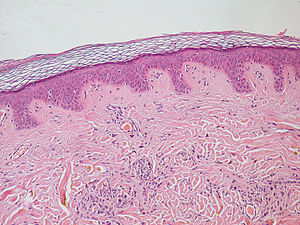Benign tumors
| Benign tumor | |
|---|---|
 |
|
| Normal Epidermis and Dermis with Intradermal Nevus 10x-cropped | |
| Classification and external resources | |
| Specialty | Pathology |
A benign tumor is a mass of cells (tumor) that lacks the ability to invade neighboring tissue or metastasize. These characteristics are required for a tumor to be defined as cancerous and therefore benign tumors are non-cancerous. Also, benign tumors generally have a slower growth rate than malignant tumors and the tumor cells are usually more differentiated (cells have normal features). Benign tumors are typically surrounded by an outer surface (fibrous sheath of connective tissue) or remain with the epithelium. Common examples of benign tumors include moles and uterine fibroids.
Although benign tumors will not metastasize or locally invade tissues, some types may still produce negative health effects. The growth of benign tumors produces a "mass effect" that can compress tissues and may cause nerve damage, reduction of blood to an area of the body (ischaemia), tissue death (necrosis) and organ damage. The mass effect of tumors are more prominent if the tumor is within an enclosed space such as the cranium, respiratory tract, sinus or inside bones. Tumors of endocrine tissues may overproduce certain hormones, especially when the cells are well differentiated. Examples include thyroid adenomas and adrenocortical adenomas.
Although most benign tumors are not life-threatening, many types of benign tumors have the potential to become cancerous (malignant) through a process known as tumour progression. For this reason and other possible negative health effects, some benign tumors are removed by surgery.
...
Wikipedia
